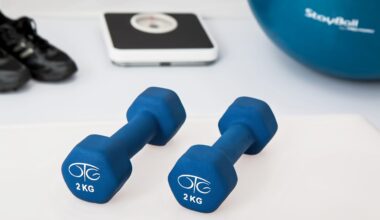Flexibility Tests Every Tennis Player Should Know
Flexibility is essential in tennis, enhancing performance and reducing injury risk. Tennis players must assess their flexibility regularly through established tests. Regular assessments help identify areas needing improvement. It also provides clear benchmarks to track progress as flexibility enhances overall athletic performance. One common flexibility test is the sit-and-reach test, which targets the hamstrings, lower back, and hips. The test winner stretches sitting on the ground while reaching forward. The distance achieved reveals how effective the flexibility levels are in the lower back and hamstring regions. Another effective measure is the shoulder flexibility test; this assesses how well players can rotate and hold their racquets during play. This test involves using a towel to check elasticity in shoulder muscles, which is vital for a tennis swing. Tests of hip flexibility are crucial too, as the hips play a significant role in movement and rotation during matches. Dedicated flexibility routines focusing on hamstrings and shoulders can improve performance. Incorporating these tests into a training regimen is beneficial!
Flexibility not only enhances performance but also helps in avoiding injuries. Tennis can put considerable strain on a player’s body, particularly on areas prone to tension like the shoulders and hips. Tension can lead to injuries, affecting play and overall health. Successful athletes are frequently those who can maintain their flexibility through consistent workouts. A dedicated warm-up structure involving dynamic stretching can increase flexibility levels before practice, which is crucial for competitors striving to excel. Players should also incorporate static stretching routines into their training after workouts. Focus on miotatic stretch techniques involving gradual lengthening of muscles and connective tissues. Improving flexibility is achievable through holistic training approaches. For instance, practicing yoga or Pilates can augment a player’s flexibility. These disciplines emphasize controlled movements and deep stretching, which ease muscle tension and promote better range of motion. In summary, flexibility coaching is integral for tennis players’ overall fitness. Regular assessments of flexibility should play a part in every competitor’s training plan, helping them to improve on the court.
Common Flexibility Tests
When considering flexibility assessments, it’s essential to know various tests widely used in athletic training. The sit-and-reach test, mentioned earlier, is effective for lower body flexibility evaluation. Performers sit, legs straight, while they stretch forward, attempting to reach beyond their toes. Performance can be measured based on specific benchmarks appropriate for age and gender. Furthermore, another effective assessment is the standing quadriceps stretch test, in which players stand while pulling a foot toward the glutes, measuring the quadriceps flexibility. A flexible quadriceps muscle can enhance sprint speed and change of direction. Another popular measurement is the trunk rotation test; this assesses thoracic mobility. Players stand with feet shoulder-width apart, twisting to gauge rotation abilities in their spine. Adequate trunk rotation improves a player’s strokes, including serves and groundstrokes. Therefore, understanding how to perform these tests and interpreting results is critical. Implementing them will enhance flexibility training regimens, leading to tangible performance improvements.
Performance improvement through flexibility training requires specialized attention. Incorporating assessments and corrective measures is vital for players striving for excellence. Post-testing analysis should indicate what flexibility aspects need enhancing. Therefore, developing dynamic stretching routines tailored to enhance specific areas targeted in assessments is beneficial. Tennis usually involves lateral movements and rapid changes in direction; therefore, focusing on hip adductors and hip flexors is crucial. With an established comprehensive flexibility program, tennis players can enhance agility and mobility on the court. Consistency is key; for maximum benefits, regular testing along with ongoing flexibility training ensures proper development. Additionally, configuration of timing throughout a season enables focused flexibility training. Engaging in flexibility workouts during off-seasons or pre-tournament phases prepares muscles adequately. To gain a competitive edge, players should maintain the flexibility levels attained through ongoing assessments, despite changes in physical activity. Furthermore, consistency influences long-term success, which makes maintaining results essential for all serious competitors.
Benefits of Flexibility for Performance
Improving flexibility facilitates better on-court performance in numerous ways. Players often underestimate the importance flexibility has for endurance and overall athletic performance. Enhanced flexibility leads to smoother motion in swings and movements; this can result in a significant increase in shot accuracy. Furthermore, players often utilize full extension during strokes; this is particularly true for serves. Good flexibility helps achieve optimal body positions during shots, reducing tension and enhances balance. Moreover, flexibility assists in the quicker recovery after intense matches, helping ease muscle soreness following competitions. Well-stretched muscles recover more effectively, enabling athletes to maintain higher performance levels consistently. Consequently, flexible athletes can hold their physical condition longer, navigating the physical demands of tennis more adeptly than others. It is beneficial for reducing injury rates during practice or matches, preserving longevity in the sport. Consequently, both short-term and long-term advantages from increased flexibility contribute to improved player effectiveness in competitions.
To optimize flexibility training, players should design balanced routines incorporating all key muscle groups. Specific role players in matches need to maintain flexibility across various muscle areas used during play. Integration of balanced resistance training alongside flexibility exercises is vital to achieving better outcomes. By prioritizing balanced workout routines that involve both stretching and strength, players establish focused training plans that enhance performance. A blend of strength and flexibility creates a more resilient athlete overall. It’s essential to consider the significance of cooling down and avoiding overstretching, which can lead to injuries. Players should engage in post-match stretching to prevent tightness and injury potential. Recovery-based stretching aids muscle relaxation while helping the body transition back to resting state. It’s an effective way to prepare the body following intense workouts or matches. Players aiming for optimal performance must always incorporate these critical practices into their regimens. These guidelines also support maintaining flexibility levels, ensuring ongoing peak performance throughout the tennis season.
Incorporating Flexibility Assessments into Routine
As players look to enhance their flexibility assessments within their routines, establishing regular intervals for testing is necessary. Planning testing sessions would make fitting them into structured workouts easier. Players should aim for assessing their flexibility every month, allowing enough time for noticeable changes. After every test, documenting results ensures proper tracking of progress over time. This strategy allows for comparisons between assessments and makes it easy to adjust training plans accordingly. Creating a structured flexibility assessment program enhances player motivation as they see improvements over time. Discussions with coaches can also foster a competitive spirit, encouraging athletes to push their limits while maintaining safe practices. Coaches play a vital role in managing this process; they can provide assessments, evaluate results, suggest workouts, and monitor progress accurately. Regular assessments with coaches and peers can motivate players to maintain their dedication to flexibility training. It’s important to reinforce a growth mindset during assessments to ensure that players remain focused, understanding the potential for improvements that can lead to continued success on the court!
In conclusion, maintaining proper flexibility is crucial for tennis players striving to enhance performance and reduce injury risk. Incorporating regular assessments alongside tailored flexibility routines can lead to significant improvements in agility and movement on the court. Understanding the various tests available and embracing dedicated training plans lays the groundwork for sustainable success. Much of a player’s success hinges on their flexibility levels, marking it as a often neglected aspect of overall fitness. Coaches also play a vital role in monitoring flexibility training while ensuring athletes remain motivated throughout their fitness journey. Players focused on improving flexibility can witness tangible benefits that can bolster their performance over time. Flexibility assessments should, therefore, be an integral part of every tennis player’s training program. By continuously working on flexibility, players will enhance not only their current performance but also their long-term athletic capabilities. As tennis is a physically demanding sport, developing effective flexibility techniques becomes crucial. This strategy will ultimately help players enjoy the sport for many years while remaining competitive in their athletic pursuits!


